Religion is an important part of Greek life and culture, as can easily be seen from the hundreds of churches and monasteries on the island.
The majority of churches dates back to XVII and XVIII centuries and is constituted by a single nave, an imposing facade, a bell tower and ceilings decorated with frescoes.
Below we describe the churches and monasteries on the island who have a history or characteristics that make them more interesting.

MONASTERY OF SAN GERASIMOS
The Monastery of Agios Gerasimos is the largest and most famous of all Kefalonia.
It is situated in the south of the island near the villages of Valsamata and Fragata on Omala plateau, 400 meters above sea level.
To get there you pass first by a garden with 40 old wells.
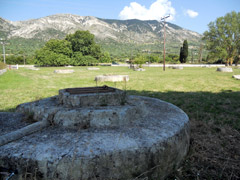 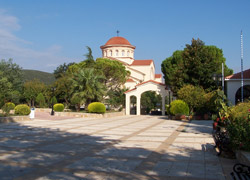
This monastery is dedicated to the patron saint of Kefalonia: Agios Gerasimos whose remains are kept in the monastery in a silver casket which is periodically opened by the priest of the church to allow pilgrims to apply directly to the Holy prayers and to kiss the remains.
The remains of the saint are a place of pilgrimage not only for the inhabitants of the island but for all Greeks.
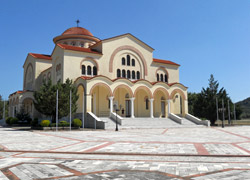 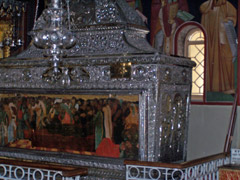
Agios Gerasimos founded this monastery in the middle of the sixteenth century, initially building a small cave where he slept and then was built above the cave monastery church.
Even today you can go to the cave that has two rooms and visit the chapel where it is kept above the body of the saint.
Chased the monastery grew but collapsed during the earthquake of 1953 and slowly rebuilt in the style of Byzantine and now has a small chapel and a new church very large and richly decorated.
Inside was made entirely in the imposing marble bishop's throne and the surfaces of the ceiling and walls are decorated with paintings in the Byzantine style.
The church contains some ceiling murals depicting scenes from the Old Testament: Baptism and Birth of Christ, the Annunciation and the Rise of the Kingdom of Heaven, the Last Supper, the Crucifixion, Christ's descent into hell and the miracle of Pentecost.
More important is the fresco of the death of St. Gerasimos depicted with Christ near the deathbed holding arm already in the soul of the deceased symbolized by a child in swaddling clothes.
Aghios Gerasimos died in 1579 and was canonized in 1622, was famous for its miraculous ability with those who suffered from mental illness.
Even now, those who suffer from disorders related to the mind turns to the Saint for help.
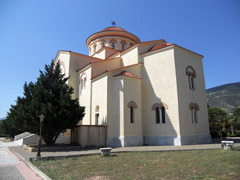 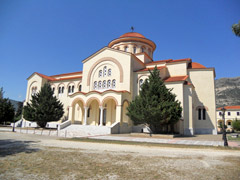
Two festivals are celebrated in the monastery: August 16th, the day that commemorates the death of Gerasimos and October 20, the date of transfer of the remains of the monastery.
On these occasions there is a procession during which the relics of the saint are carried under the shade of a plane tree that was planted by the saint.
We attend church authorities, policies, and Cefaloniti thousands of tourists and the procession follows a big party with music, dancing, food and wine.

KIPOURIA MONASTERY
We suggest you to visit the Monastery of Kipouria more for its position than for its natural beauty.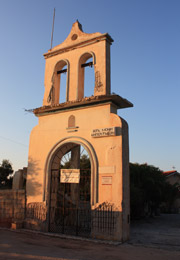
Located 15 km from Lixouri is built on top of the cliffs on the west coast of the peninsula of Lixouri and is overlooking the sea.
Very isolated has no other buildings in the neighborhood and it is surrounded only by trees and nature.
You can not get here by mistake because it's not on a passing road, you must want to come here starting from the village of Kaminarata or Havdata and we suggest you to come with the sunset as the sun goes down into the sea in front of the terrace of the monastery.
Its name "Kipouria" comes from "kipos" (land, vegetable garden) in fact the monks to support themselves cultivated all the lands around the monastery.
The monastery was built in the seventeenth century and in 1759 the church of the monastery was built by Chrysanthos Petropoulos who dedicated it to the Annunciation of the Virgin and the exaltation of the Holy Cross.
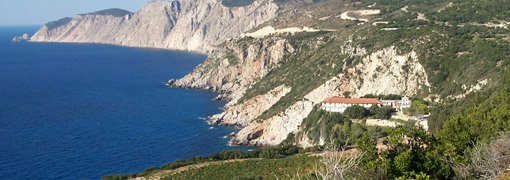
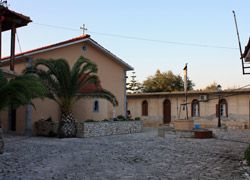 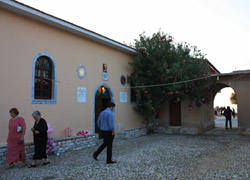
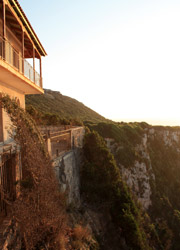 In the monastery you can see a piece of the Holy Cross, which was donated to the monastery by the Russian Prince Vladimir Dolgorukov in 1862. In the monastery you can see a piece of the Holy Cross, which was donated to the monastery by the Russian Prince Vladimir Dolgorukov in 1862.
In a small, elegant bottle you will see the oil Agios Dimitrios (VII century) and also you will have the opportunity to venerate the relics of several saints and the icon of Agia Parakevi, the only relic of the monastery destroyed by Tafiou.
Today is not harmonious to see the combination of the entrance door (very nice), the Church, the old parts of the monastery with the two more modern buildings that reduce the beauty of the wide-ranging.
The monastery celebrates four different events: March 25 The Annunciation of the Virgin, the third Sunday of fasting, September 14 the Exaltation of the Holy Cross and July 26 Agia Paraskevi.

AGIOS ANDREAS MONASTERY
The Monastery of Agios Andrea Milapidias is located in the village of Peratata in the south of the island of Kefalonia.
At Peratata you can visit not only the castle but also the monastery and the museum that it's inside it.
The monastery was founded in 1579, renovated in 1639 and then suffered the devastation, including the famous earthquake of 1953, that brought to light many frescoes of the sixteenth century.
Today, the monastery is a convent of nuns, a museum that houses a unique collection of beautiful Byzantine icons and ecclesiastical objects and one of the most important pilgrimage destinations thanks to a very important relic preserved in it: the foot of the Apostle Andrew.
Inside the monastery, in 2002, a special building was dedicated to the museum, on two floors, where wood carvings, icons and even entire iconostasis are exposed.
In the first room there are the frescoes of the temple of Milapidia Monastery including images from the Passion of Christ, works of the monk Theodoros Poulakis, and images of the three hierarchs by the deacon Athanasios Anninos.
Among the exhibits there are also the shroud of Gregory V, Patriarch of Constantinople, the stole of Agios Nektarios and the shirt of Agios Panagis.
In the museum you will also see two Epistles of Agios Kosmas written in 1777 and the archepiscope bag of Kefalonia, embroidered by the nun Theodora Kanali between 1715 and 1721 with the image of Christ, on one side, and the Virgin Mary on the other.
At the monastery there are celebrations twice a year: on November 30 in memory of the Apostle Andrew and Friday of "diakeninismou" (the week following the Orthodox Easter) in memory of Zoodochou Pigi, the second patron of the monastery.
You can visit the monastery every day from 7.00 to 14.00 and from 17.00 to 20.00, while the museum is open every day, except Sunday, from 8.00 to 14.00.

ATROU MONASTERY
The Monastery of Theotokou Atrou is the oldest monastery on the island dating back to 1264.
It's
located on the mountain Atrou, just north of Poros, at 550 meters above sea level. 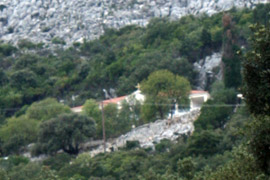
The unpaved and dead-end street leading to the monastery starts from the village of Riva and continues for more than 4 km.
It is not an easy road and we recommend you a jeep but it is wonderful to see Poros and the surrounding vegetation from the top.
The monastery has been destroyed and rebuilt several times and today only the courtyard at the entrance and the medieval tower (10 meters tall), remain to be seen.
In the past century, in this monastery, Saint Klimis was ascetic and Hegumen.
The monastery celebrates its feast on the 8th of September (the Virgin birth).

AGRILLION MONASTERY
The monastery of Agrilion is located on the road linking Sami and the famous Antisami beach and it is dedicated to the Theotokos Iperaghia.
It was built in the eighteenth century on the site where, in 1722, was found the miraculous icon of Aghia Theotokos.
Continuing along the road, after the monastery, there are the ruins of the ancient Sami, another church and various nature trails to visit the area.

THEMATON MONASTERY
The Thematon monastery is located in a short distance from Aghia Efimia, in the center of the island.
To reach the monastery, starting from Ag. Efimia, you have to go inland to the village of Drakopoulata and then continue to the mountain of Agia Dinati.
The monastery is about 600 meters above sea level and it is surrounded by greenery. The road leading to the monastery then becomes unpaved and coming back you will see beautiful views.
Thematon in greek means "facts" and there is a legend that the inhabitants of the island come to pray at the monastery to ask which "facts" or actions they have to do to solve their problems.
Others argue that Thematon was the name of a local governor.
In this monastery the festivities take place on Easter Tuesday and August 15.

CHURCH OF THE VIRGIN MARY LUGUVARDAS
The church of the Virgin Mary Laguvarda is located in the village of Markopoulo and was built on the ruins of an old monastery destroyed by the Turks.
According to local legend, when, in 1705, the monastery was attacked by pirates, the scared nuns prayed to Madonna of being turned into serpents to escape the cruelty of their captors.
The prayers were answered and the nuns were turned into snakes that did escape the pirates with fear.
Since then, every year on the day of August the nuns-snakes return to the monastery to bring good luck and prosperity to the village.
This legend explains why, every 15th August, harmless little snakes appear inside and around the church and at end of the day they disappear.
This is another of the mysteries that characterize the island of Kefalonia.

 SAINT SPIRIDONA CHURCH SAINT SPIRIDONA CHURCH
The church of Saint Spiridona in Argostoli is decorated with a great golden and carved wood temple that has been moved here from the old cathedral.
From this church began the annual procession which takes place to remeber the earthquake of 1953.

ARGOSTOLI CATHEDRAL
The Cathedral of Argostoli, before the earthquake of 1953 during which it was destroyed, was in the pedestrian street "Lithastrato" and was dedicated to "Sotira".
It was rebuilt in the years subsequent to earthquake and today it is in Vergati street.
Part of the building comes from the ancient church of Our Lady of Fussatu and inside there are also icons by the famous hagiographer Theodoro Pulaki.

SISSION MONASTERY
The Monastery of Our Lady of Sission is located in the bay of Lourda and more precisely on the unpaved road that leads to the beaches of Pelagaki and Heavens.
Seems it was built in the thirteenth century by St. Francis of Assisi, a version that is supported by the name "Sission."
Once the monastery was very rich and important monks lived there including painter Gerasimos Kokkinos.
Today only the ruins and part of the facade remain to be seen.
Among the still existent icons there is the "Madonna of Akathistu Imnu", painted by Tsagkaiola of Crete, which is kept in the Museum of Sant 'Andrea in Peratata.

|











 In the monastery you can see a piece of the Holy Cross, which was donated to the monastery by the Russian Prince Vladimir Dolgorukov in 1862.
In the monastery you can see a piece of the Holy Cross, which was donated to the monastery by the Russian Prince Vladimir Dolgorukov in 1862.
 SAINT SPIRIDONA CHURCH
SAINT SPIRIDONA CHURCH